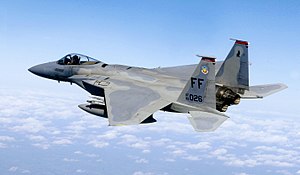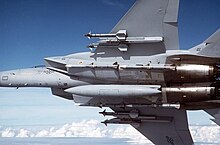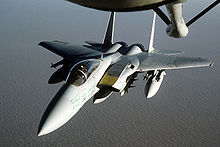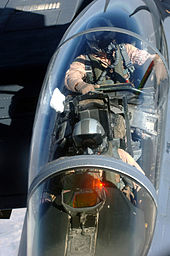From Wikipedia, the free encyclopedia
This article is about the initial F-15 fighter versions. For the current production versions, see McDonnell Douglas F-15E Strike Eagle.
| F-15 Eagle | |
|---|---|
| USAF F-15C during an Operation Noble Eagle patrol | |
| Role | Air superiority fighter |
| Manufacturer | McDonnell Douglas Boeing Defense, Space & Security |
| First flight | 27 July 1972 |
| Introduction | 9 January 1976 |
| Status | Active |
| Primary users | United States Air Force Japan Air Self-Defense Force Royal Saudi Air Force Israeli Air Force |
| Number built | F-15A/B/C/D/J/DJ: 1,198[1] |
| Unit cost | F-15A/B: US$28 million (1998) F-15C/D: US$30 million (1998)[2] |
| Variants | McDonnell Douglas F-15E Strike Eagle McDonnell Douglas F-15 STOL/MTD Boeing F-15SE Silent Eagle Mitsubishi F-15J |
Since the 1970s, the Eagle has been exported to Israel, Japan, Saudi Arabia, and other nations. The F-15 was originally envisioned as a pure air superiority aircraft. Its design included a secondary ground-attack capability[5] that was largely unused. The design proved flexible enough that an all-weather strike derivative, the F-15E Strike Eagle, was later developed, and entered service in 1989. The F-15 Eagle is expected to be in service with the U.S. Air Force past 2025.[6] F-15 versions are still being produced for foreign users, with the F-15 production line set to end in 2019, 47 years after the type's first flight.[7]
Development
Origins
Following studies in 1964–1965, the U.S. Air Force developed requirements for an air superiority fighter in October 1965. Then on 8 December 1965, the service issued a request for proposals (RFP) for the new fighter. The request called for both air-to-air and air-to-ground capabilities. Eight companies responded with proposals. In the following study phase, four of these companies developed some 500 design concepts. Typical designs featured variable-sweep wings, weighed over 60,000 lb (27,200 kg), included a top speed of Mach 2.7 and a thrust-to-weight ratio of 0.75.[8] The designs were not accepted by the Air Force as they compromised fighter qualities for ground attack qualities.[9] Acceptance of the Energy-Maneuverability (E-M) theory by the Air Force led to a change in requirements for improved maneuverability by the spring 1967. The design mission weight was reduced to 40,000 lb (18,100 kg), top speed reduced to Mach 2.3–2.5 and thrust-to-weight ratio increased to 0.97.[8]In 1967 U.S. intelligence was surprised[10] to find that the Soviet Union was producing a large fighter aircraft, the MiG-25 'Foxbat'.[11] It was not known in the West at the time that the MiG-25 was designed as a high-speed interceptor, not an air superiority fighter,[12] so its primary asset was speed, not maneuverability. The MiG-25's huge tailplanes and vertical stabilizers (tail fins) hinted at a very maneuverable aircraft, which worried the Air Force that its performance might be better than its U.S. counterparts. In reality, the MiG's large fins and stabilators were necessary to prevent the aircraft from encountering inertia coupling in high-speed, high-altitude flight.[citation needed]
The McDonnell Douglas F-4 Phantom II of the USAF, U.S. Navy and U.S. Marine Corps was the only fighter with enough power, range, and maneuverability to be given the primary task of dealing with the threat of Soviet fighters while flying with visual engagement rules.[11] As a matter of policy, the Phantoms could not engage targets without positive visual identification, so they could not engage targets at long ranges, as designed. Medium-range AIM-7 Sparrow missiles, and to a lesser degree even the AIM-9 Sidewinder, were often unreliable and ineffective at close ranges where it was found that guns were often the only effective weapon.[13] The Phantom did not originally have any guns or cannons, but experience in Vietnam led to the addition of an internally mounted cannon in later versions.
F-X program

F-15A cockpit
The Eagle's initial versions were the F-15 single-seat variant and TF-15 twin-seat variant. (After the F-15C was first flown in 1980 the designations were changed to "F-15A" and "F-15B"). These versions would be powered by new Pratt & Whitney F100 engines to achieve a combat thrust-to-weight ratio in excess of 1. A proposed 25 mm Ford-Philco GAU-7 cannon with caseless ammunition suffered development problems. It was dropped in favor of the standard M61 Vulcan gun. The F-15 used conformal carriage of four Sparrow missiles like the Phantom. The fixed wing was put onto a flat, wide fuselage that also provided an effective lifting surface. The first F-15A flight was made in July 1972 with the first flight of the two-seat F-15B following in July 1973.[17]
The F-15 has a "look-down/shoot-down" radar that can distinguish low-flying moving targets from ground clutter. The F-15 would use computer technology with new controls and displays to lower pilot workload and require only one pilot to save weight. Unlike the F-14 or F-4, the F-15 has only a single canopy frame with clear vision forward. The USAF introduced the F-15 as "the first dedicated USAF air superiority fighter since the North American F-86 Sabre."[18]
The F-15 was favored by customers such as the Israel and Japan air arms. Criticism from the fighter mafia that the F-15 was too large to be a dedicated dogfighter, and too expensive to procure in large numbers, led to the Lightweight Fighter (LWF) program, which led to the USAF General Dynamics F-16 Fighting Falcon and the middle-weight Navy McDonnell Douglas F/A-18 Hornet.[19]
Further development
The single-seat F-15C and two-seat F-15D models entered production in 1978 and conducted their first flights in February and June of that year.[20] These models were fitted with the Production Eagle Package (PEP 2000), which included 2,000 lb (900 kg) of additional internal fuel, provisions for carrying exterior conformal fuel tanks, and an increased maximum takeoff weight of up to 68,000 lb (30,700 kg).[21] The increased takeoff weight allows internal fuel, a full weapons load, conformal fuel tanks, and three external fuel tanks to be carried. The APG-63 radar uses a programmable signal processor (PSP), enabling the radar to be reprogrammable for additional purposes such as the addition of new armaments and equipment. The PSP was the first of its kind in the world, and the upgraded APG-63 radar was the first radar to use it. Other improvements on the C and D models included strengthened landing gear, a new digital central computer,[22] and an overload warning system, which allows the pilot to fly the fighter to 9 g at all weights.[20]The F-15 Multistage Improvement Program (MSIP) was initiated in February 1983 with the first production MSIP F-15C produced in 1985. Improvements included an upgraded central computer; a Programmable Armament Control Set, allowing for advanced versions of the AIM-7, AIM-9, and AIM-120A missiles; and an expanded Tactical Electronic Warfare System that provides improvements to the ALR-56C radar warning receiver and ALQ-135 countermeasure set. The final 43 F-15Cs included the enhanced-capability Hughes APG-70 radar, which was developed for the F-15E. These 43 F-15Cs with APG-70 radar are sometimes referred as Enhanced Eagles. Earlier MSIP F-15Cs with the APG-63 were upgraded to the APG-63(V)1 to significantly improve maintainability and enable performance similar to the APG-70. Existing F-15s were retrofitted with these improvements.[23]
In 1979, McDonnell Douglas and F-15 radar manufacturer, Hughes, teamed to privately develop a strike fighter version of the F-15. This version competed in the Air Force's Dual-Role Fighter competition starting in 1982. The Boeing F-15E strike variant was selected for production in 1984.[24] Beginning in 1985, F-15C and D models were equipped with the improved P&W F100-220 engine and digital engine controls, providing quicker throttle response, reduced wear, and lower fuel consumption. Starting in 1997, original F100-100 engines were upgraded to a similar configuration with the designation F100-220E starting.[25]
Beginning in 2007, 178 USAF F-15Cs were retrofitted with the AN/APG-63(V)3 Active Electronically Scanned Array (AESA) radar.[26] A significant number of F-15s are to be equipped with the Joint Helmet Mounted Cueing System (JHMCS).[27] Lockheed Martin is working on an IRST system for the F-15C.[28] A follow-on upgrade called the Eagle passive/active warning survivability system (EPAWSS) was planned but remained unfunded.[29]
Design
Overview
The F-15 has an all-metal semi-monocoque fuselage with a large cantilever shoulder-mounted wing. The empennage is metal and composite construction, with twin aluminum/composite honeycomb fins with boron-composite skins, resulting in an exceptionally thin tailplane and rudders with all-moving composite horizontal tail surfaces outboard of the fins. The F-15 has a spine-mounted air brake and retractable tricycle landing gear. It is powered by two Pratt & Whitney F100 axial-flow turbofan engines with afterburners mounted side-by-side in the fuselage. The cockpit is mounted high in the forward fuselage with a one-piece windscreen and large canopy to increase visibility.The F-15's maneuverability is derived from low wing loading (weight to wing area ratio) with a high thrust-to-weight ratio enabling the aircraft to turn tightly without losing airspeed. The F-15 can climb to 30,000 ft (10,000 m) in around 60 seconds. The thrust output of the dual engines is greater than the aircraft's weight, thus giving it the ability to accelerate in a vertical climb. The weapons and flight control systems are designed so that one person can safely and effectively perform air-to-air combat.[14] The A and C-models are single-seat variants; these were the main air superiority versions produced. B and D-models add a second seat behind the pilot for training. E-models use the second seat for a weapon systems officer. Visibly, the F-15 has a unique feature vis a vis other modern fighter aircraft in that it does not have the distinctive turkey feather aerodynamic exhaust petals covering its engine nozzles. This is because the petal design on the F-15 was problematic and could fall off in flight; therefore they were removed, resulting in a 3% drag increase.[30]
Avionics
A multi-mission avionics system includes a heads-up display (HUD), advanced radar, inertial guidance system (INS), flight instruments, ultra high frequency (UHF) communications, and Tactical Air Navigation (TACAN) and Instrument Landing System (ILS) receivers. It also has an internally mounted, tactical electronic-warfare system, identification, friend or foe (IFF) system, electronic countermeasures suite and a central digital computer.[31]
A wing over maneuver displays the clean lines and high-wing design of an F-15E from Elmendorf AFB, Alaska.
The F-15's versatile APG-63/70 pulse-Doppler radar system can look up at high-flying targets and down at low-flying targets without being confused by ground clutter. It can detect and track aircraft and small high-speed targets at distances beyond visual range (the maximum being 120 nautical miles (220 km) away) down to close range, and at altitudes down to treetop level. The radar feeds target information into the central computer for effective weapons delivery. The capability of locking onto targets as far as 50 nautical miles (90 km) with an AIM-120 AMRAAM missile enables true beyond visual range (BVR) engagement of targets. For close-in dogfights, the radar automatically acquires enemy aircraft, and this information is projected on the heads-up display. The F-15's electronic warfare system provides both threat warning and automatic countermeasures against selected threats.[33]
Weaponry and external stores
The Eagle can be armed with combinations of four different air-to-air weapons: AIM-7F/M Sparrow missiles or AIM-120 AMRAAM advanced medium range air-to-air missiles on its lower fuselage corners, AIM-9L/M Sidewinder or AIM-120 AMRAAM missiles on two pylons under the wings, and an internal M61A1 20 mm Gatling gun in the right wing root.[35]
Low-drag conformal fuel tanks (CFTs) were developed for the F-15C and D models. They can be attached to the sides of the engine air intake trunks under each wing and are designed to the same load factors and airspeed limits as the basic aircraft.[35] They degrade performance by increasing drag and cannot be jettisoned in-flight (unlike conventional external tanks). Each conformal fuel tank can hold 750 U.S. gallons (2,840 L) of fuel.[36] These tanks increase range and reduce the need for in-flight refueling. All external stations for munitions remain available with the tanks in use. Moreover, Sparrow or AMRAAM missiles can be attached to the corners of the conformal fuel tanks.[21] The 57 FIS based at Keflavik NAS, Iceland was the only C-model squadron to use CFTs on a regular basis due to its extended operations over the North Atlantic. With the closure of the 57 FIS, the F-15E is the only variant to carry them on a routine basis. CFTs have also been sold to Israel and Saudi Arabia.
Upgrades
The APG-63(V)2 Active Electronically Scanned Array (AESA) radar has been retrofitted to 18 U.S. Air Force F-15C aircraft.[38] This upgrade includes most of the new hardware from the APG-63(V)1, but adds an AESA to provide increased pilot situational awareness. The AESA radar has an exceptionally agile beam, providing nearly instantaneous track updates and enhanced multi-target tracking capability. The APG-63(V)2 is compatible with current F-15C weapon loads and enables pilots to take full advantage of AIM-120 capabilities, simultaneously guiding multiple missiles to several targets widely spaced in azimuth, elevation, or range.
Operational history
Introduction and early service
The largest operator of the F-15 is the United States Air Force. The first Eagle (F-15B) was delivered 13 November 1974.[39] In January 1976, the first Eagle destined for a combat squadron, the 555th TFS, was delivered.[39] These initial aircraft carried the Hughes Aircraft (now Raytheon) APG-63 radar.The first F-15 kill was scored by Israeli Air Force (IAF) ace Moshe Melnik in 1979.[40] In 1979–81, during Israeli raids against Palestinian factions based in Lebanon, F-15As downed 13 Syrian MiG-21 "Fishbeds" and two Syrian MiG-25 "Foxbats", the latter being the aircraft the F-15 was designed to kill. Israeli F-15As and Bs participated as escorts in Operation Opera and served during the 1982 Lebanon War. During the latter, Israeli F-15s shot down 40 Syrian jet fighters (23 MiG-21 "Fishbeds" and 17 MiG-23 "Floggers") and one Syrian SA.342L Gazelle helicopter.[41] Later during 1985, IAF Eagles, in Operation Wooden Leg, bombed the PLO headquarters in Tunisia.[42] This was one of the few times air superiority F-15s (A/B/C/D models) were used in tactical strike missions. The air to ground role for the air superiority variants became more frequently used in Israeli service starting from the opening years of the new century with the integration of GPS guided bombs.
Royal Saudi Air Force F-15C pilots shot down two Iranian Air Force F-4E Phantom IIs in a skirmish in June 1984, and shot down two Iraqi Mirage F1s during the Gulf War.[43][44][45]
Anti-satellite trials
The third test flight involved a retired P78-1 solar observatory satellite in a 345-mile (555 km) orbit, which was destroyed by kinetic energy.[48] The pilot, USAF Major Wilbert D. "Doug" Pearson, became the only pilot to destroy a satellite.[49][50] The ASAT program involved five test launches. The program was officially terminated in 1988.[46][49]
Gulf War and aftermath
The USAF began deploying F-15C, D and E model aircraft to the Persian Gulf region in August 1990 for Operations Desert Shield and Desert Storm. During Gulf War combat against Iraqi forces, they accounted for 36 of the 39 Air Force air-to-air victories. F-15Es were operated mainly at night, hunting modified SCUD missile launchers and artillery sites using the LANTIRN system.[51] According to the USAF, its F-15Cs had 34 confirmed kills of Iraqi aircraft during the 1991 Gulf War, mostly by missile fire: five MiG-29 "Fulcrums", two MiG-25 "Foxbats", eight MiG-23 "Floggers", two MiG-21 "Fishbeds", two Su-25 "Frogfoots", four Su-22 "Fitters", one Su-7, six Mirage F1s, one Il-76 cargo plane, one Pilatus PC-9 trainer, and two Mi-8 helicopters. Air superiority was achieved in the first three days of the conflict; many of the later kills were reportedly of Iraqi aircraft fleeing to Iran, rather than trying to engage U.S. aircraft. The single-seat F-15C was used for air superiority, and the F-15E was heavily used in air-to-ground attacks. An F-15E achieved an aerial kill of another Iraqi Mi-8 helicopter using a laser-guided bomb during the air war. The F-15E sustained two losses to ground fire in the Gulf War in 1991.[52] Another one was damaged on the ground by a SCUD strike on Dhahran air base.[53]Structural defects
All F-15 aircraft were grounded by the US Air Force after a Missouri Air National Guard F-15C came apart in flight and crashed on 2 November 2007. The newer F-15E fleet was later cleared for continued operations. The US Air Force reported on 28 November 2007 that a critical location in the upper longerons on the F-15C model was suspected of causing the failure, causing the fuselage forward of the air intakes, including the cockpit and radome, to separate from the airframe.[55]F-15A through D-model aircraft were ordered grounded until the location received more detailed inspections and repairs as needed.[56] The grounding of F-15s received media attention as it began to place strains on the nation's air defense efforts.[57] The grounding forced some states to rely on their neighboring states' fighters for air defense protection, and Alaska to depend on Canadian Forces' fighter support.[57]
On 8 January 2008, the USAF Air Combat Command (ACC) cleared a portion of its F-15A through D-model fleet for return to flying status. It also recommended a limited return to flight for units worldwide using the affected models.[58] The accident review board report was released on 10 January 2008. The report stated that analysis of the F-15C wreckage determined that the longeron did not meet drawing specifications, which led to fatigue cracks and finally a catastrophic failure of the remaining support structures and breakup of the aircraft in flight.[59] In a report released on 10 January 2008, nine other F-15s were identified to have similar problems in the longeron. As a result of these problems, General John D. W. Corley stated that "the long-term future of the F-15 is in question."[60] On 15 February 2008, ACC cleared all its grounded F-15A/B/C/D fighters for flight pending inspections, engineering reviews and any needed repairs. ACC also recommended release of other U.S. F-15A/B/C/D aircraft.[61]
Recent service
Indian Air Force (IAF) Su-30MKs, MiG-29s and other fighters achieved success in air combat exercises against U.S. Air Force (USAF) F-15Cs during "Cope India" in February 2004. The U.S. agreed not to use beyond visual range AIM-120 missiles on its fighters.[62][63][64] During the USAF's Red Flag advanced combat training exercises in 2008, American F-15Cs, F-16Cs, and F-22s bested Indian Su-30MKIs. The Su-30s operated with their radars in training mode to keep their signals secret.[65]The F-15 in all air forces had a combined air-to-air combat record of 104 kills to 0 losses as of February 2008.[66] No air superiority versions of the F-15 (A/B/C/D models) have been shot down by enemy forces. Over half of F-15 kills were achieved by Israeli Air Force pilots.
On 16 September 2009, the last F-15A, an Oregon Air National Guard aircraft, was retired marking the end of service for the F-15A and F-15B models in the United States.[67]
With the retirement of the F-15A and B models, the F-15C and D models are being supplemented in U.S. service by the F-22 Raptor. However since F-22 production has been halted, the F-15 may be in service in current squadrons much longer than originally thought. As of 2013, Regular Air Force F-15C and F-15D fighters are based overseas with the Pacific Air Forces (PACAF) at Kadena AB in Japan[68] and with the U.S. Air Forces in Europe (USAFE) at RAF Lakenheath in the United Kingdom.[69] Other Regular Air Force F-15s are operated by Air Combat Command as adversary/aggressor platforms at Nellis AFB, Nevada, and by Air Force Material Command in test and evaluation roles at Edwards AFB, California and Eglin AFB, Florida. All remaining combat coded F-15Cs and F-15Ds are operated by the Air National Guard.
USAF is upgrading 178 F-15C/Ds with the AN/APG-63(V)3 AESA radar,[26] and upgrade other F-15s with the Joint Helmet Mounted Cueing System.[27] The Air Force plans to keep 178 F-15C/Ds along with 224 F-15Es in service beyond 2025. The F-15E will remain in service for years to come because of the model's primary air-to-ground role and the lower number of hours on the F-15E airframes.[6]
Variants
Basic models

USAF F-15C fires an AIM-7 Sparrow in 2005.
- F-15A
- Single-seat all-weather air-superiority fighter version, 384 built 1972–1979.[70]
- F-15B
- Two-seat training version, formerly designated TF-15A, 61 built 1972–1979.[70]
- F-15C
- Improved single-seat all-weather air-superiority fighter version, 483 built 1979–1985.[70] The last 43 F-15Cs are being upgraded with AN/APG-70 radar.
- F-15D
- Two-seat training version, 92 built 1979–1985.[70]
- F-15J
- Single-seat all-weather air-superiority fighter version for the Japan Air Self-Defense Force 139 built under license in Japan by Mitsubishi 1981–1997, two built in St. Louis.[70]
- F-15DJ
- Two-seat training version for the Japan Air Self-Defense Force. 12 built in St. Louis, and 25 built under license in Japan by Mitsubishi during 1981–1997.[70]
- F-15N Sea Eagle
- The F-15N was a carrier-capable variant proposed in the early 1970s to the U.S. Navy as an alternative to the heavier and, at the time, considered as "riskier" technology program: Grumman F-14 Tomcat. The F-15N-PHX was another proposed naval version capable of carrying the AIM-54 Phoenix missile. These featured folding wingtips, reinforced landing gear and a stronger tailhook for shipboard operation.[71]
- F-15E Strike Eagle
- See McDonnell Douglas F-15E Strike Eagle for F-15E, F-15I, F-15S, F-15K, F-15SG, and other F-15E-based variants.
- F-15SE Silent Eagle
- See Boeing F-15SE Silent Eagle for a recent proposed F-15E variant with a reduced radar signature.










No comments:
Post a Comment